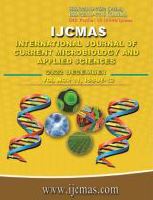


 National Academy of Agricultural Sciences (NAAS)
National Academy of Agricultural Sciences (NAAS)

|
PRINT ISSN : 2319-7692
Online ISSN : 2319-7706 Issues : 12 per year Publisher : Excellent Publishers Email : editorijcmas@gmail.com / submit@ijcmas.com Editor-in-chief: Dr.M.Prakash Index Copernicus ICV 2018: 95.39 NAAS RATING 2020: 5.38 |
Dermatophytes that may affect up to 20% of the global population. Fungal contamination during tattooing is thought to be due to the presence of fungal pathogens in the tattoo needle. The study aims to detect and molecular study to Dermatophytes sp. That isolated from people with tattoos in Diyala governorate of Iraq. Across sectional study was done in the period from 1st October 2020 until 15th February 2021 in Baquba teaching hospital (Consulting clinic).The study including 100 patients (43 were male and 57 female) aged from (10-65 years old). After the preparation of samples and detection of subtilisin-like protease gene by PCR, the teqnition sent the sample that has this gene to sequencing. The results showed the frequency of fungi species as follows T.mentagrophytes formed (9.0%), T.rubrum formed(3.0%), T.nigra (3.0%), M.audouinii (3.0%), M.gypseum (3.0%), other growth (29.0%), no growth (50.0%), with highly significant(P<0.05). Depending on the age groups, it was found T.mentagrophytes constituted the highest incidence of fungal infection in age groups (21-30 years old) followed by (31-40 years old) and (41-50 years old) with percentages (33.3%,22.2%, and 22.2%) respectively. The fungal species M.gypseum, T. nigra, and T. rubrum were found to have the highest incidence of infection in age groups (31-40) with (33.3%) for fungi infections (M.gypseum, T. nigra, and T. rubrum). As well, Other growth and No growth constituted the highest incidence rate for the same age group (44.8% and 38.0%) respectively. The differences between age groups and inbred races were significant (p <0.05). Depending on the gender, T. rubrum, no growth, and T.mentagrophytes were found, which constituted the highest rates of infection in males (66.70%, 56.00%, and 34.50%) respectively. In females, M.audouinii, T. rubrum, and T.mentagrophytes formed the highest rates of infection (100.00%, 100.00%, and 77.80%) respectively. The differences between fungal infection and gender were not significant (p> 0.5). Depending on the housing, T. nigra, no growth, and other growth were found, it highest rates of infection were found in people living in rural areas (66.70%, 40.00%, and 44.40%) respectively. As for the people who live in the city, T. nigra, Other growth, and M.gypseum formed the highest rates of infection (100.00%, 75.90%, and 66.70%) respectively. The differences between fungal infection and habitation were not significant (p> 0.5). Depending on education level, M.gypseum, T. nigra, and M.audouinii were found, it highest rates of infection among people were those who graduated from secondary school with (66.70%). Other growth and no growth also constituted a high rate of infection among secondary school graduates, with a percentage (58.60% and 46.00%) respectively. The differences between fungal infection and education level were not significant (p> 0.5). The results of the sequence were 96.22% similar to the T. rubrum standard and record in the Gene bank of NCBI.
 |
 |
 |
 |
 |